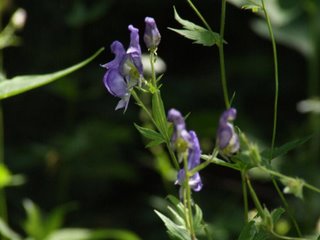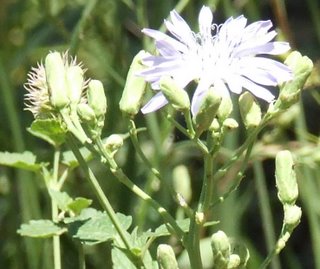Scouting for Flowers

*grins* These are just cool. They're called Monkshood (Aconitum columbianum), though they look more like smurf's hats to me. Don't be fooled, though. They're deadly poisonous. And the leaves DO look somewhat like geranium leaves. Geraniums are often gathered for medicinal purposes; there's a warning only to gather them while they're in bloom, because of similarity to this plant. Oh, and their scientific name, Aconite, means "wolf's bane" in Greek. The plant was sometimes used to poison meat in wolf-traps. By contrast, this one is edible. It was growing in the beaver pond along the trail. Arum-leaved Arrowhead, Sagittaria cuneata. At least, the roots and tubers are edible, and are supposed to taste something like sweet potatoes when cooked (they're also becoming rare due to overgrazing; cattle like to dig them out of the water).
By contrast, this one is edible. It was growing in the beaver pond along the trail. Arum-leaved Arrowhead, Sagittaria cuneata. At least, the roots and tubers are edible, and are supposed to taste something like sweet potatoes when cooked (they're also becoming rare due to overgrazing; cattle like to dig them out of the water). This could be Blue lettuce, Lactuca tatarica, or it could be Chicory, Cichorum intybus. Chicory's petals are a bit wider, so I think it's probably Chicory. Hmmm... looks like they're easier to tell apart once they've fruited.
This could be Blue lettuce, Lactuca tatarica, or it could be Chicory, Cichorum intybus. Chicory's petals are a bit wider, so I think it's probably Chicory. Hmmm... looks like they're easier to tell apart once they've fruited. Okay, this one is past flowering, but I'm just happy that I finally figured out what it was. It's serviceberry, aka saskatoon, aka Amelanchier alnafolia. This is probably the same plant that I thought might be a blueberry up the road to Chinese Peak. Anyway, the berries are edible, but I'd advise spitting out the seeds. They're known to contain compounds similar to cyanide. Cooking will destroy the toxins, though. [Edible & Medicinal Plants of the RM] I've eaten a few of these. They taste something like blueberries, but...not as strong a flavor.
Okay, this one is past flowering, but I'm just happy that I finally figured out what it was. It's serviceberry, aka saskatoon, aka Amelanchier alnafolia. This is probably the same plant that I thought might be a blueberry up the road to Chinese Peak. Anyway, the berries are edible, but I'd advise spitting out the seeds. They're known to contain compounds similar to cyanide. Cooking will destroy the toxins, though. [Edible & Medicinal Plants of the RM] I've eaten a few of these. They taste something like blueberries, but...not as strong a flavor.




No comments:
Post a Comment